Anser Enterprise – Prototyping Design, Fabricate, Test, Support
Hi. Thanks for Visiting!
In a nutshell, I provide prototyping services applying expertise in single board computers, sensors, actuators, hardware/software design and fabrication throughout the complete product design process. Also, I’m building several autonomous guided vehicles (AGV) and blogging on their progress as frequently as possible to share ideas and solicit feedback.
AGV Blog
12/6/2025 – Sprocket Mounting Hub (Weld on)
I designed a new sprocket hub that allows a 55 tooth #25 chain sprocket to attached to a 10″ pneumatic tire wheel. The sprocket hub’s design allows it to be welded onto the the end of the wheel’s 1.5″ rim hub. Custom welding jigs are used to ensure that the sprocket is concentrically aligned with the wheel axle and there is no side-to-side wobble of the sprocket as it rotates. The welding jigs consist of a clamping bolt through both the rim and sprocket hubs, securely holding the sprocket hub plate against the end of the rim hub behind the flange bearing, and an internal copper cylinder matching the inner diameters of the rim and sprocket hubs. Four half-circle plug welding holes near the ID of the sprocket hub allow for easy welding on the accessible side of the weld locations.
To see pictures of the assembled wheel, sprocket and sprocket hub, visit the Shop link above.
10/1/2025 Sprocket Mounting Hub (Removable)
This describes the design and fabricated of a sprocket hub with the primary advantage of easy attachment and axial adjustment on 1.5″ OD wheel rim hubs. Materials used consist of 1.5″ ID, 1/8″ wall steel tubing (DOM) for the hub collars, 2 hub collar set screws securing it to the wheel rim hub and 3/16″ thick 2″ steel squares used for the sprocket hub plates each with 4 threaded screw holes to mount the sprocket. Fabrication operations include
- Drilling/tapping set screw holes through perpendicular planes in the steel tubing sides
- Lathe parting 1″ long collars from the steel tubing stock ensuring their ends were square, required for the hub plate welding
- Cutting 2″ squares from the 3/16″ thick, 2″ wide rectangular bar stock
- Clamping and welding the steel squares perpendicularly to the ends of the hub collars.
- Lathe facing a 1/16″ boss registration feature matching the sprocket ID to ensure concentricity of the sprocket and collar.
- Boring the inside of the hub collar to achieve a good fit to the wheel rim hub.
- CNC/manual mill drilling/tapping 4 sprocket mounting screw holes at the corners of the squares.
Here are images of the sprocket hub and assemblies with the 10″ pneumatic tire wheel and 55 tooth #25 chain sprocket.
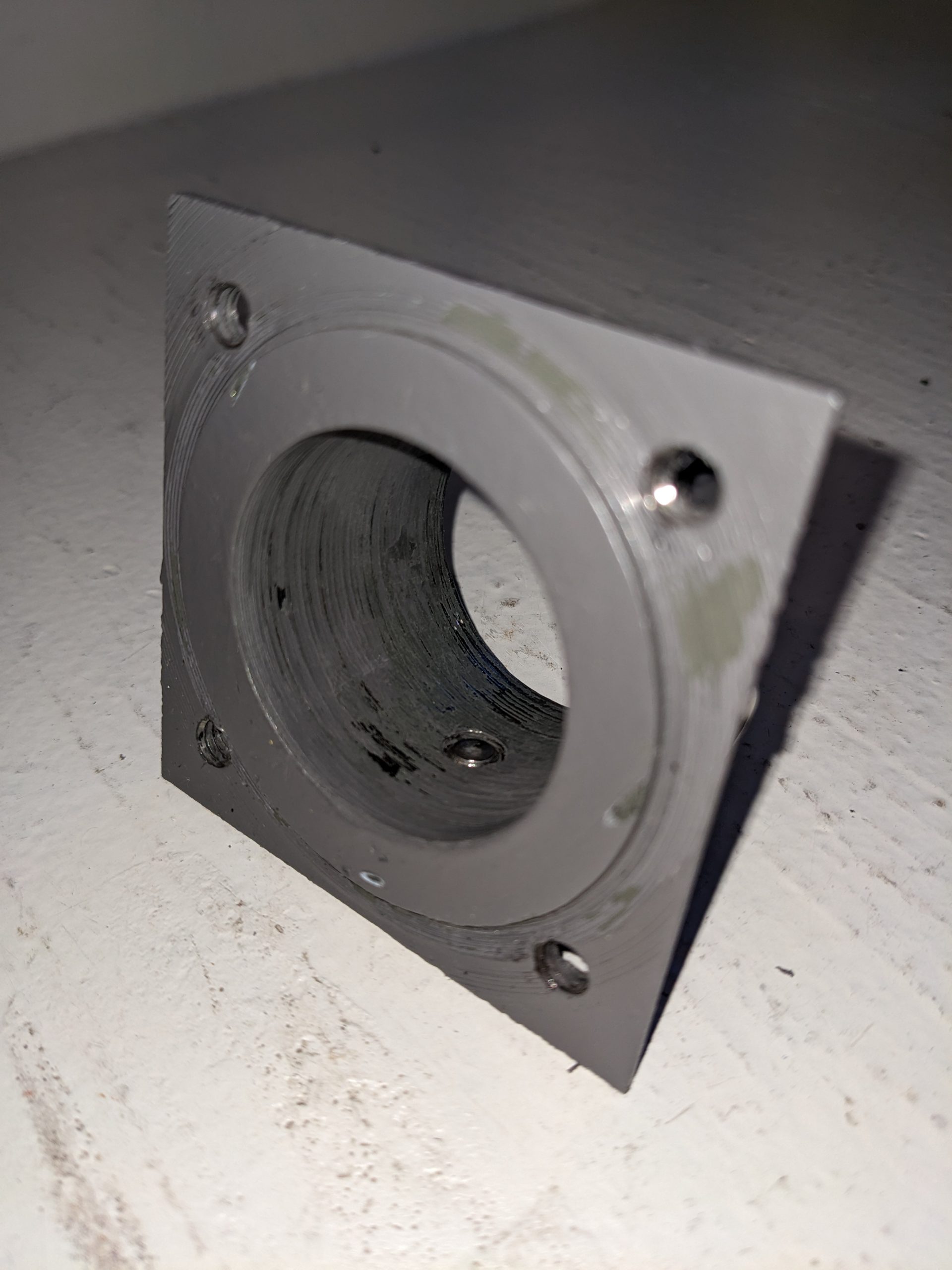
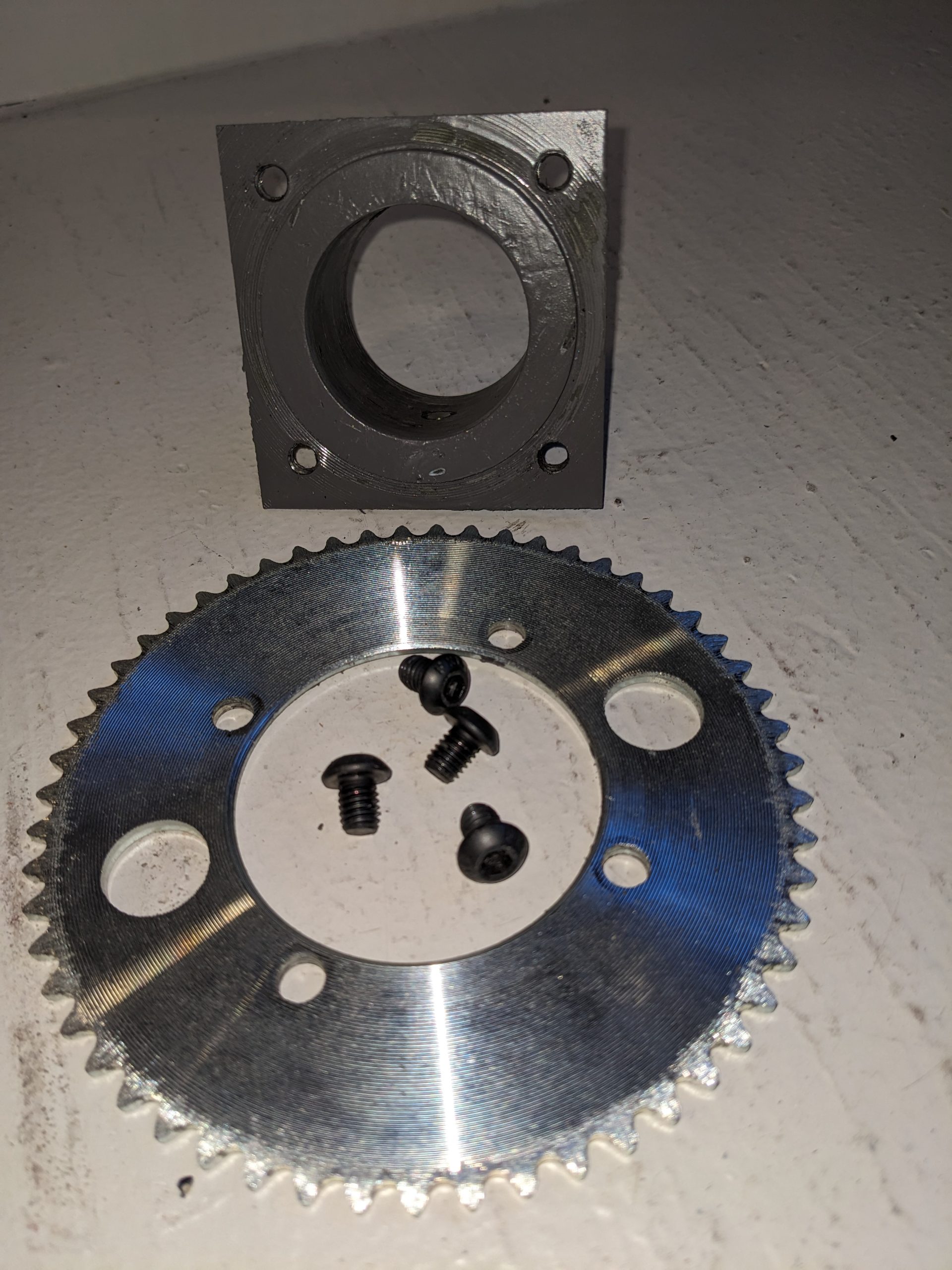

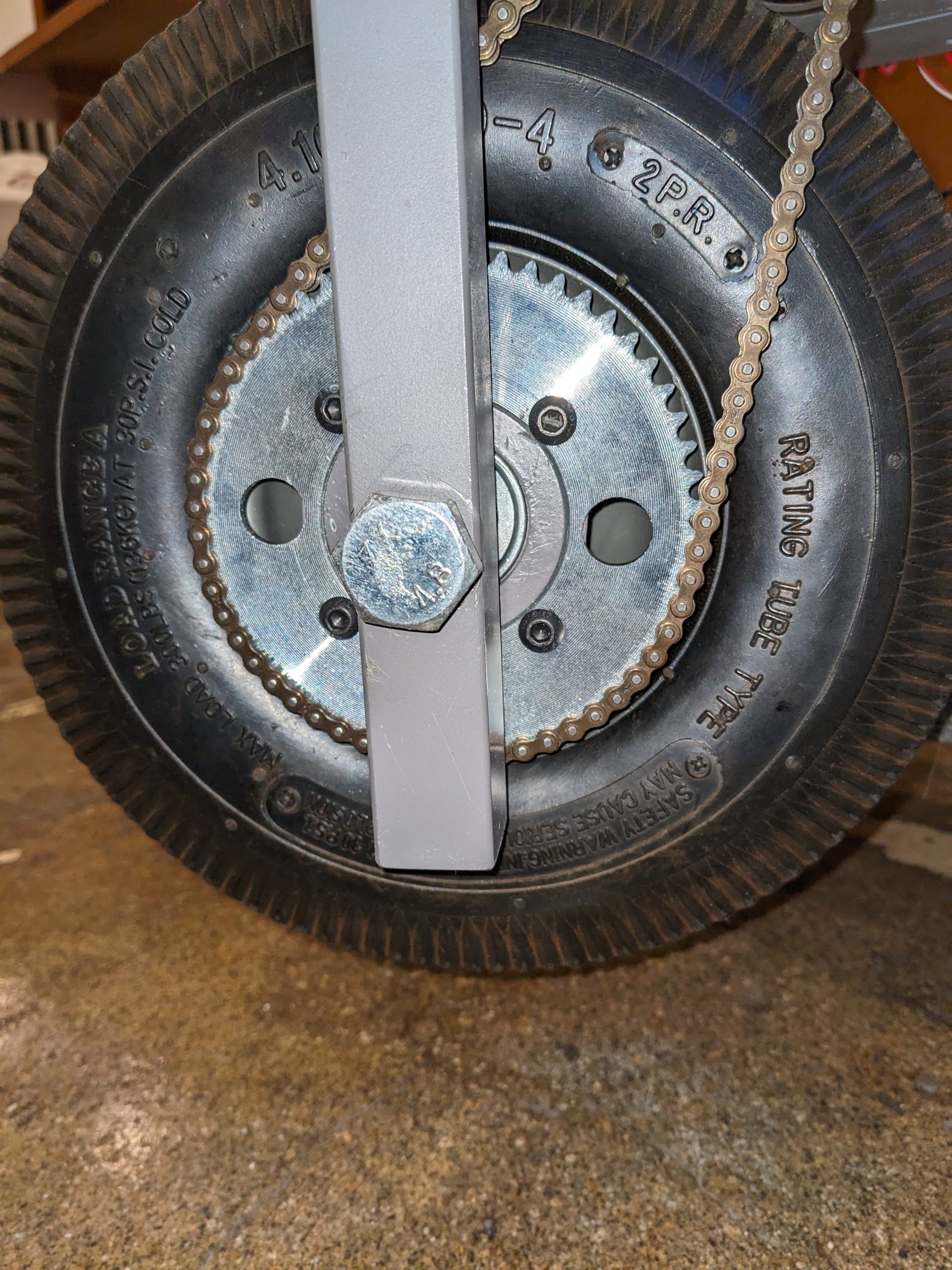
9/11/2025 Rear Chain Guard Re-Design
I changed the design of the rear sprocket guards and 3D printed them.

The front half-circular guard section required no changes since I can insert and remove it easily by turning it 90 degrees, sliding it between the top and bottom frames, flexing the tabs on the ends open to slide it over the frames, unflexing to close the tabs and inserting M3 screws or pins to hold it tight against the frame.
I re-designed the single back elongated guard to be 2 pieces that could be separately slid in place from the top and bottom, thereby avoiding inference with the wheel hub, square encoder end cap and circular motor housing. Top, bottom and side M3 screw connectors on the guards hold the 3 guard pieces together.

The above picture shows the opposite side of the guards and frames facing the inside of the AGV. It shows the semicircular cutouts for the cylindrical motor housing.
9/5/2025 Chain Guard Design
I’m reviewing 3D Printed guards designed to protect #25 chains and sprockets. A primary constraint in their design is that they need to be the last components easily added (and removed), completing a vehicle’s assembly. Easy access for adjusting the drive mechanism is the main reason. For the tank-driven four wheel vehicle these guards are two half circular ‘clam shells’ that snap in place around sprockets driving 10″ pneumatic tire wheels as well as square steel tubing making up the vehicle frame.
This is an image of 2 half circular guards covering the sprocket. The circular cutout in the center of the 2 guards allows for clearance of the 1.5″ diameter wheel hub. The sprocket is mounted on the end of the hub inside the guards.

Here are images of the guards covering the back sprocket.

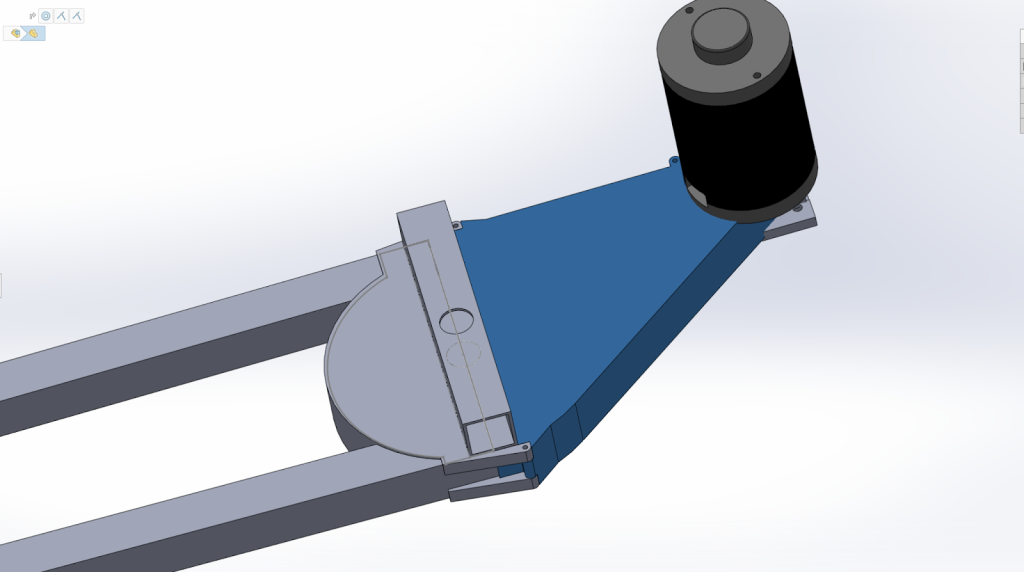
The front half guard has the same circular shape to cover the sprocket. Whereas the back guard is elongated to additionally protect the chain where it travels under the back sprocket and up to the smaller motor pinion.
Installing the back elongated guard is done by flexing open the guard, thereby widening the lengthwise split in the top, slipping it up and over the bottom chain and top horizontal frame, unflexing to let it wrap around the top frame and securely closing the guard on top with M3 screws through the two sets of small cylindrical connectors printed into the guard.
9/2/2025 Welding Jigs for Parallelism of Four Corner Vertical Frame Tubing
Issue: The four wheeled AGV frame consists of machined horizontal and vertical 1″ x 1″ 16 gauge steel tubing pieces welding together. In addition the vehicle platform has four vertical 7/8″ x 7/8″ x 3″ tubing stubs at the platform’s corners that insert tightly into the four 1×1 vertical frame sections of the two side assemblies. A key manufacturability requirement is that the four vertical 1×1 tubing pieces are welded into the side assemblies as parallel as possible to one another. Otherwise, the platform’s stubs will bind when inserted 3 inches into the tops of the 1×1 verticals. The use of welding magnetics and vice clamps doesn’t guarantee parallelism and slows the welding setup process considerably.
Solution: To address this issue, I fabricated jigs, described below, to help ensure parallelism.
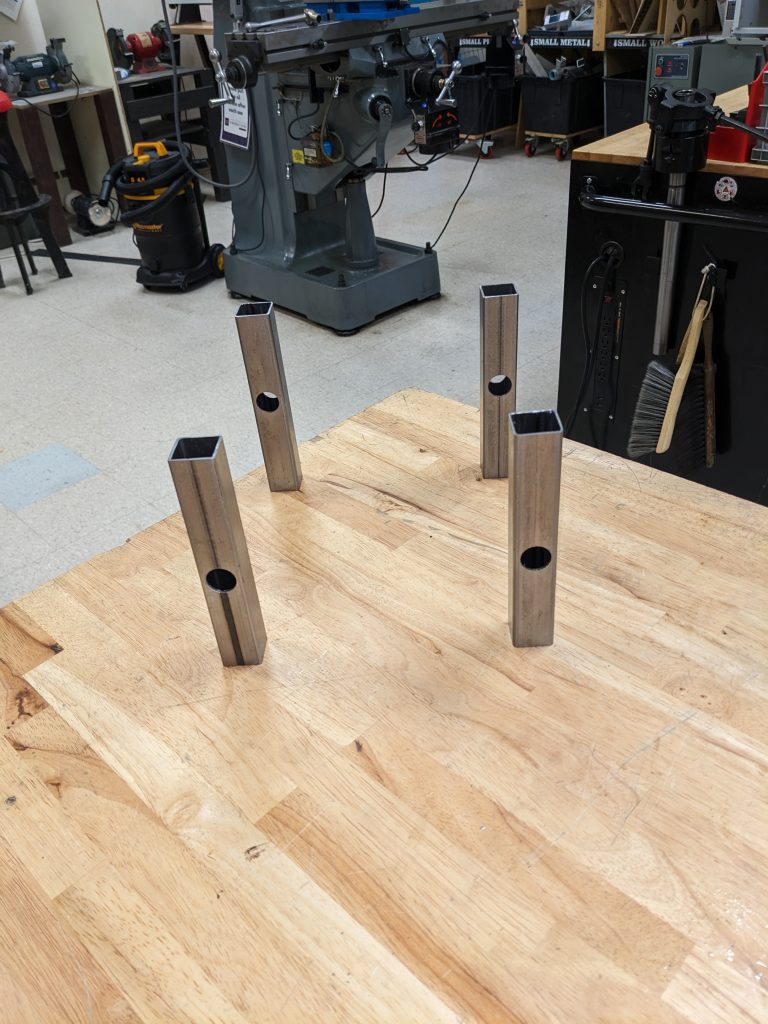

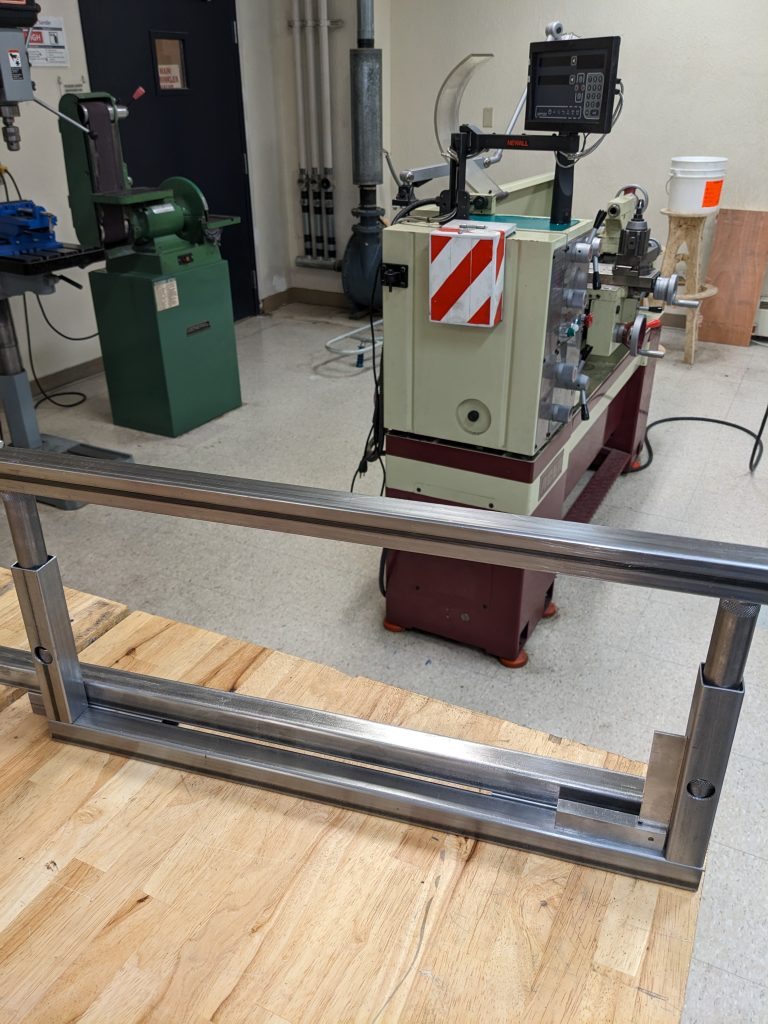
Each of the 2 identical jigs includes two 7/8″ round stock steel bars cut to 3″ lengths with ends milled square. The inside dimensions of the 1×1 tubing is presumably 7/8″ x 7/8″ but the fit with the 7/8″ round bar stock was still too loose to ensure parallelism. Therefore, I knurled 1/4″ of both ends of the round bars providing the tight fit required. Then the ends are drilled, tapped and screwed at the ends of spare 1×1 tubing at the correct distances (20″) required for the vehicle side assemblies. The two jigs are inserted into opposite ends of the four vertical frame pierces and perpendicularity of the vertical frames to the base spare 1×1 tubing is checked to guarantee parallelism of the verticals. Finally, the jigs with verticals are laid sideways and clamped on top of the top and bottom horizontal frame pieces between the verticals and the welding table to ensure parallelism in the orthogonal direction as well. Welds are done inside the two ends of the bottom horizontal tubing through 1/4″ wide slots cut in the wall of the bottom tubing in connect with the vertical. As was done for the front end of the top horizontal tubing and top of its vertical. For the weld of the top horizontal and top of the back vertical the weld had to be do inside the top end of the vertical with the welding slot cut in the vertical instead. This is because the top horizontal tubing extends another 6″ beyond the vertical to provide for the motor mount at the rear of the AGV. Inside welds eliminate the need for grinding and interference of welds with the guards and generally improve the appearance of the AGV.
9/2/1015 Controller, Printed Circuit Board, and Wiring Details
Using EasyEDA PCB Design Software, I previously designed and ordered 100×100 mm printed circuit boards from JLCPCB. Also, I designed a 6″x4″x2″ acrylic PCB enclosure using SolidWorks and LaserCAD software and cut the enclosure sides from .118″ clear acrylic sheets using a BOSS Laser HP3655. After soldering all the electronic components onto the PCB the task remained to neatly route the 14 gauge wiring coming in from the battery and going from the BTS7960 motor driver modules to the 100 watt 12V MY6812 DC motors. I used SolidWorks again to create a 3D model of the PCB enclosure base with the PCB mounted on standoffs, 12V to 5V buck convertor, and WAGO lever wire connectors primarily for the 14 gauge wiring.
Here is an image of the PCB Enclosure SolidWorks model showing battery GND wiring from the orange WAGO lever nut connectors to the green B- screw terminal ports of the four BTS7060 motor driver modules.
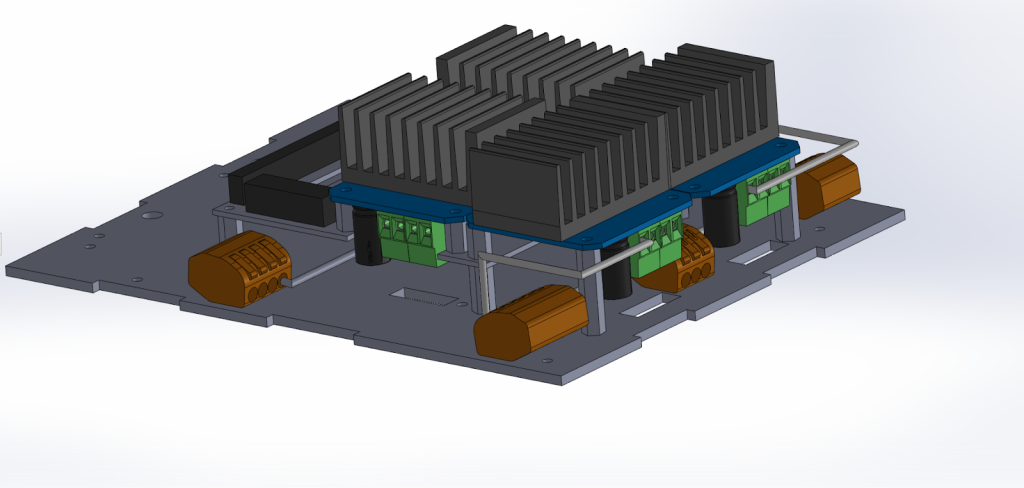
The point of the visualization is to accurately determine the lengths of the wire segments between bends, bend directions and optimized wire routing given the compact design of the PCB. A remaining manufacturability task is to fabricate wiring jigs to form the wiring shapes efficiently.
8/15/2025 CNC Machining Top Frame Tubing
The tank-driven four wheel driven AGV is fabricated primarily from 16 gauge 1″x1″ square steel tubing, which is machined manually or on Tormach PCNC 1100 Mill and Tormach 15L Pro-Slant CNC Lathe machines. Presented here are machining configurations and operations generated in SolidWorks CAM software. This image shows CAD features to be machined in one of the frame components.

For this part, I stepped though a series of SolidWorks CAM software definitions/configurations such as Define Machine, Coordinate System, Stock Manager, Mill Setup. For Coordinate System, I oriented the Z-direction such that a 1/4″ end mill could be programmed to plunge down and machine out a complete U-shaped pass through for the motor shaft, sprocket pinion and encoder. The X-axis is along the length of the tubing and the Y-axis is along the tubing’s 1″ cross section.

Mill Part Setup 1 is defined to be an Open Pocket (Rough-Finish) operation. Using the SolidWorks CAM 2.5 Axis Feature: Select Entities dialog I specified the sketch to use for the feature profile to machine, an End condition of 1.10″ to machine through both sides of the tubing, a 2.5 Axis Feature Type: Open Pocket, Strategy: Rough-Feature.
Using the ‘Generate Operation Plan’ command, I created the machining operations for the machinable features, based on rules defined in SolidWorks Technology Database. Both Rough Mill and Contour Mill with 0.25″ Flat End operations were produced for the Open Pocket.
Using the ‘Generate Toolpath’ command, the CAM software produced the tool path movements highlighted in light green in this image.

Next, the ‘Simulate Toolpath’ command is used to animate the end mill moving according to the toolpath above.
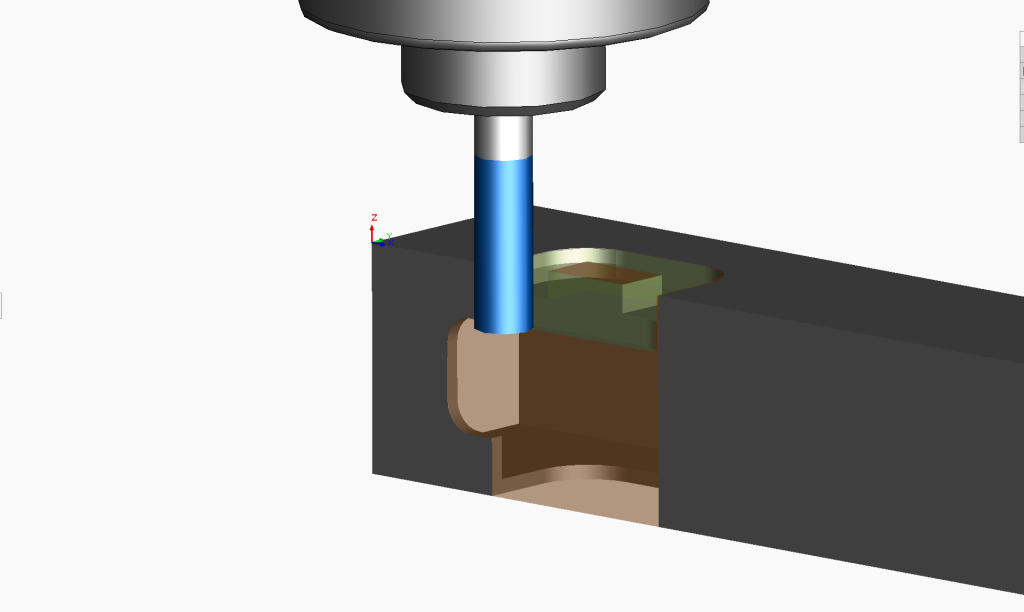
Finally, the ‘Post Process’ command is used to generate the G Code that is transferred to the CNC Mill.
Looking down on the top frame held on its side on the mill table, notice that the toolpath in the image below starts at Y: -0.06” outside the tubing. Therefore when it plunges down, the center of the 4 flute ¼” end mill is not forced into the material, necessary because it has no drilling action at its center.
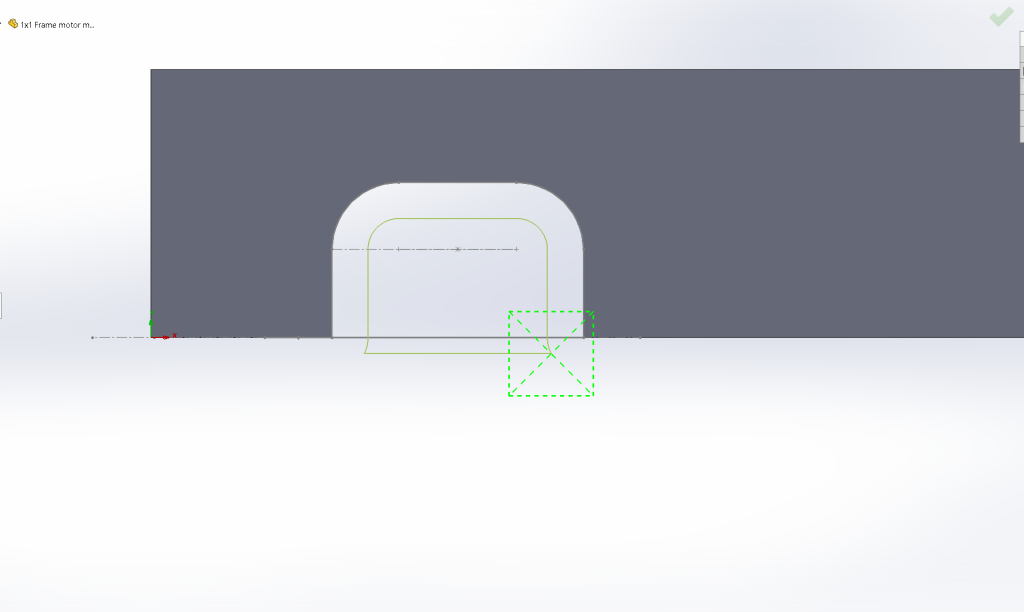
Also, see in the toolpath outside the material above and in this G Code segment below that there are G03 circular interpolation commands implementing the lead-in and lead-out parameters. This defines how the side of the end mill enters and exits the material.
O0001
N1 G20
N2 (1/4 EM HSS 4FL 3/4 LOC)
N3 G91 G28 X0 Y0 Z0
N4 T20 M06
N5 S1252 M03
N6 ( Rough Mill1 )
N7 G90 G54 G00 X1.493 Y-.06
N8 G43 Z.1 H20 M08
N9 G01 Z-.125 F1.2529
N10 G17 X.7959 F5.0115
N11 G03 X.81 Y0 I-.1209 J.06
N12 G01 Y.329
N13 G02 X.925 Y.444 I.115 J0
N14 G01 X1.3639
N15 G02 X1.4789 Y.329 I0 J-.115
N16 G01 Y0
N17 G03 X1.493 Y-.06 I.135 J0
N18 G00 Z.1
6/1/2025 Four Wheel Chain Drive vs. Direct Drive Decision
Per a Google AI generated comparison, choice of mechanical drives depends on the application and other factors. See below:
AI Overview
For a four-wheel robot, the better drive system depends on your specific needs for power, precision, and maintenance. A direct drive is simpler, more efficient, and more accurate, making it ideal for lighter robots requiring precision. A chain drive, on the other hand, is better for heavy-duty robots that need high torque and durability while allowing for flexible motor placement.
Direct drive
A direct drive system connects the motor shaft directly to the wheel, eliminating intermediate components like chains or gears.
Pros:
- High efficiency and accuracy: With no energy lost to friction or backlash from chains, direct drives are highly efficient and offer precise control over movement.
- Low maintenance: The simple design has fewer moving parts to lubricate, align, or replace, resulting in less maintenance and more uptime.
- Compact and lightweight: Without the added bulk of chains and sprockets, a direct drive system is lighter and requires less space. This is advantageous for smaller robots.
- Instant response: The lack of a mechanical linkage reduces lag, allowing the motor to respond to commands almost instantaneously.
Cons:
- Requires powerful motors: Since there is no gear reduction, the motors must generate all the necessary torque directly, which can require more powerful and expensive motors.
- Vulnerable to shocks: If the robot takes an impact, the shock load can be transmitted directly to the motor’s gearbox, risking damage.
- Limited design flexibility: This setup locks your motor placement directly at the wheel, which can constrain your design and reduce space for other components.
- Fixed gear ratio: Changing the speed and torque ratio is difficult with a direct drive system.
Chain drive
A chain drive uses a chain to link the motor’s drive sprocket to the wheels’ driven sprockets, allowing power to be transmitted over a longer distance.
Pros:
- High torque delivery: Chain drives offer powerful torque transfer, especially over longer distances, making them suitable for heavier robots or those carrying heavy loads.
- Flexible motor placement: The motor does not need to be right next to the wheel, giving you greater freedom to place components and balance the robot’s weight.
- Impact resistance: The chain system absorbs some of the shock from impacts, protecting the more delicate motors from damage.
- Adjustable ratio: You can easily change the gear ratio by swapping out sprockets of different sizes
Cons:
- Lower efficiency: Friction in the chain links and sprockets reduces the overall energy efficiency compared to a direct drive.
- Higher maintenance: Chains require regular tensioning and lubrication to operate correctly and avoid snapping.
- Potential for failure: Chains can stretch, loosen, or snap, causing a catastrophic drivetrain failure.
- Increased weight: The chain, sprockets, and tensioning components add weight to the robot, which may reduce performance.
How to choose
To determine the best drive for your robot, consider these factors:
- Application:
- For heavy-duty robots that need maximum power and durability, such as those in robot competitions, a chain drive is often the better choice.
- For smaller, lightweight robots that need high precision for tasks like assembly or inspection, a direct drive is superior.
- Budget and complexity:
- Chain drives have a lower initial cost for the drivetrain components and offer more flexibility for novice builders.
- Direct drives may require a more expensive, specialized motor to achieve the necessary torque.
- Maintenance tolerance:
- If you need a system that requires very little upkeep, a direct drive is the best option.
- If you can perform regular inspections and tune-ups, a chain drive will serve you well.
- Space and layout:
- For designs that need motors in a central location for weight distribution or to save space, a chain drive provides the necessary layout flexibility.
- If you can design your robot around having motors at the wheels, the simplicity of a direct drive may be appealing.
In Summary
In the final decision process, I chose a chain drive to address heavy duty tasks, impact resistance, flexible motor placement, lower cost and higher torque.
Anser Enterprise
We provide an array of Resources
A comprehensive suite of professional services with access to top notch development, fabrication and testing facilities including
- Electronic design software
- Printed Circuit Board fabrication
- Laser CNC fabrication
- 3D Printing
- CNC and manual lathe and mills
We focus on innovative automation
Anser Enterprise
A comprehensive suite of mechanized platforms address the needs of a diverse clientele, ranging from hobbyist to commercial enterprises.
Development and Testing
Work with us to customize our platforms to your applications.
Continuous Support
Upgrade to our evolving hardware and software offerings as you needs expand.
App Access
Control our automation platforms from the convenience of Smart Phone, tablet or laptop browser-based apps.
Consulting
Our expertise can address you unique automaton requirement from problem definition, development, testing, installation and ongoing support.
Project Management
Coordination with experts in related disciplines to provide a total solution.
Automation Solutions
Specializing in outdoor environments addressing a range of repetitive maintenance tasks.